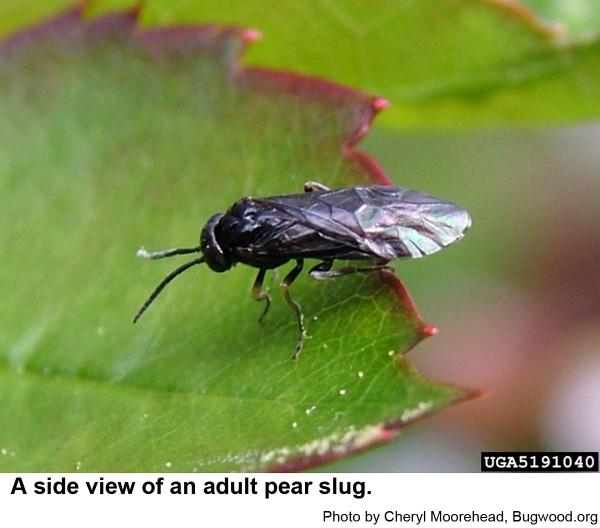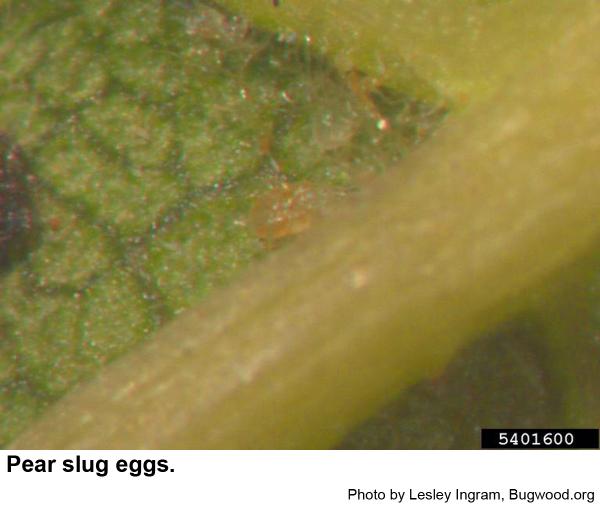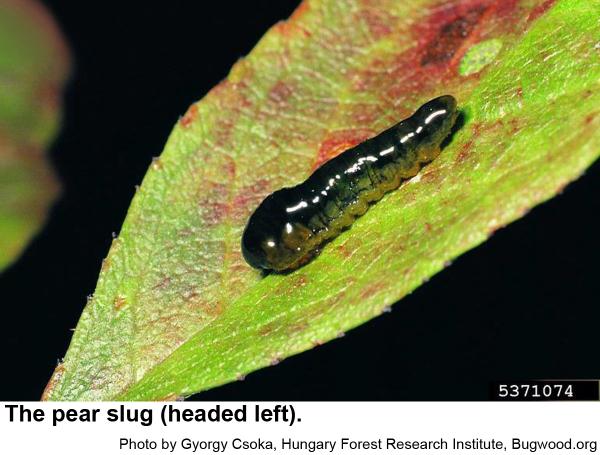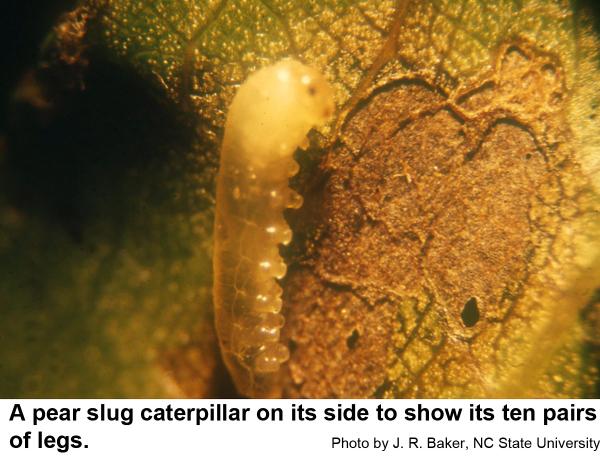Description and Biology
Pearslugs, Caliroa cerasi, are also called pear sawflies and cherryslugs. These caterpillars are called slug caterpillars because they appear wet or shiny with a sort of greenish slime. Plus their legs are so short that they do resemble true slugs in top view, but they are slightly wider at the head end. Pearslugs are the immature stages of a small, shiny black, fly-like insect — the pear sawfly — that uses its saw-like ovipositor to pierce leaves to lay eggs inside (hence the name sawfly) most often in the upper canopy. Females are almost 3/16 inch long and black with very dark feet and lower legs. The translucent, dark wings are held flat over the back. Males are similar, but slightly smaller. The egg is very small, oval, tan, and looks like a small blister on the leaf. Eggs are laid in the upper leaf surface or lower leaf surface near a rid. Eggs hatch in 10 to 15 days. Newly hatched and newly molted pearslugs bare and yellow before they secrete their blackish slime. Fully grown pearslugs are about 3/8 inch long and are slimeless and yellowish orange. They drop to the soil where they dig in 2 or 3 inches and spin a tough silken cocoon in which they eventually pupate later in the summer or in the next spring. From the cocoons emerge another generation of adult pear sawflies that continue the wheel of existence. At least two generations occur each growing season. The second generation is usually the most damaging.
Host Plants
Pearslugs feed on the upperside of leaves of pear, cherry, hawthorn, plums, quince and occasionally apple where they skeletonize the leaves (eat everything except the veins, leaving a skeleton of the leaf behind). Eggs are sometimes laid on peach leaves, but pearslugs don't seem to do well on peach. Heavily infested trees turn brown, and leaves wither and drop. Defoliation can weaken the tree.
Residential Recommendations
Pearslugs are reportedly susceptible to insecticides. Orthene, Sevin or some other insecticide labeled for use on landscape plants should give adequate control.
Other Resources
- List of the Sawflies (Hymenoptera: Symphyta) of Virginia. Smith, D. R. 2006. Banisteria, Number 28: 3 - 23. Virginia Natural History Society.
- Nearctic sawflies III: Heterarthrinae: Adults and larvae (Hymenoptera: Tenthredinidae). Smith, D. R. 1971. U.S. Department of Agriculture Technical Bulletin No. 1420. 84 pp., 18 pls.
- Pear Slug, Caliroa cerasi (Linnaeus) (Hymenoptera: Tenthredinidae). Long, L. 2012. WSU Tree Fruit Comprehensive Tree Fruit Site.
- Pear Sawfly (Pearslug), Scientific name: Caliroa cerasi. Anonymous. 2012. UC Pest Management Guidelines. UC IPM.
- Extension Plant Pathology Publications and Factsheets
- Horticultural Science Publications
- North Carolina Agricultural Chemicals Manual
For assistance with a specific problem, contact your local N.C. Cooperative Extension Center.
This Factsheet has not been peer reviewed.
Publication date: May 25, 2019
Reviewed/Revised: March 25, 2024
Recommendations for the use of agricultural chemicals are included in this publication as a convenience to the reader. The use of brand names and any mention or listing of commercial products or services in this publication does not imply endorsement by NC State University or N.C. A&T State University nor discrimination against similar products or services not mentioned. Individuals who use agricultural chemicals are responsible for ensuring that the intended use complies with current regulations and conforms to the product label. Be sure to obtain current information about usage regulations and examine a current product label before applying any chemical. For assistance, contact your local N.C. Cooperative Extension county center.
N.C. Cooperative Extension prohibits discrimination and harassment regardless of age, color, disability, family and marital status, gender identity, national origin, political beliefs, race, religion, sex (including pregnancy), sexual orientation and veteran status.





